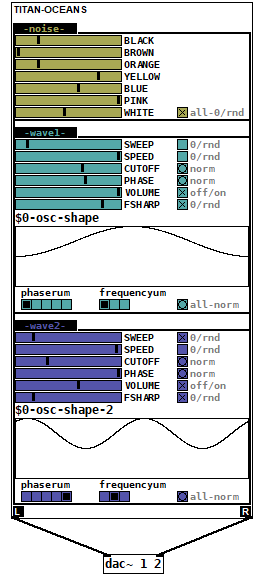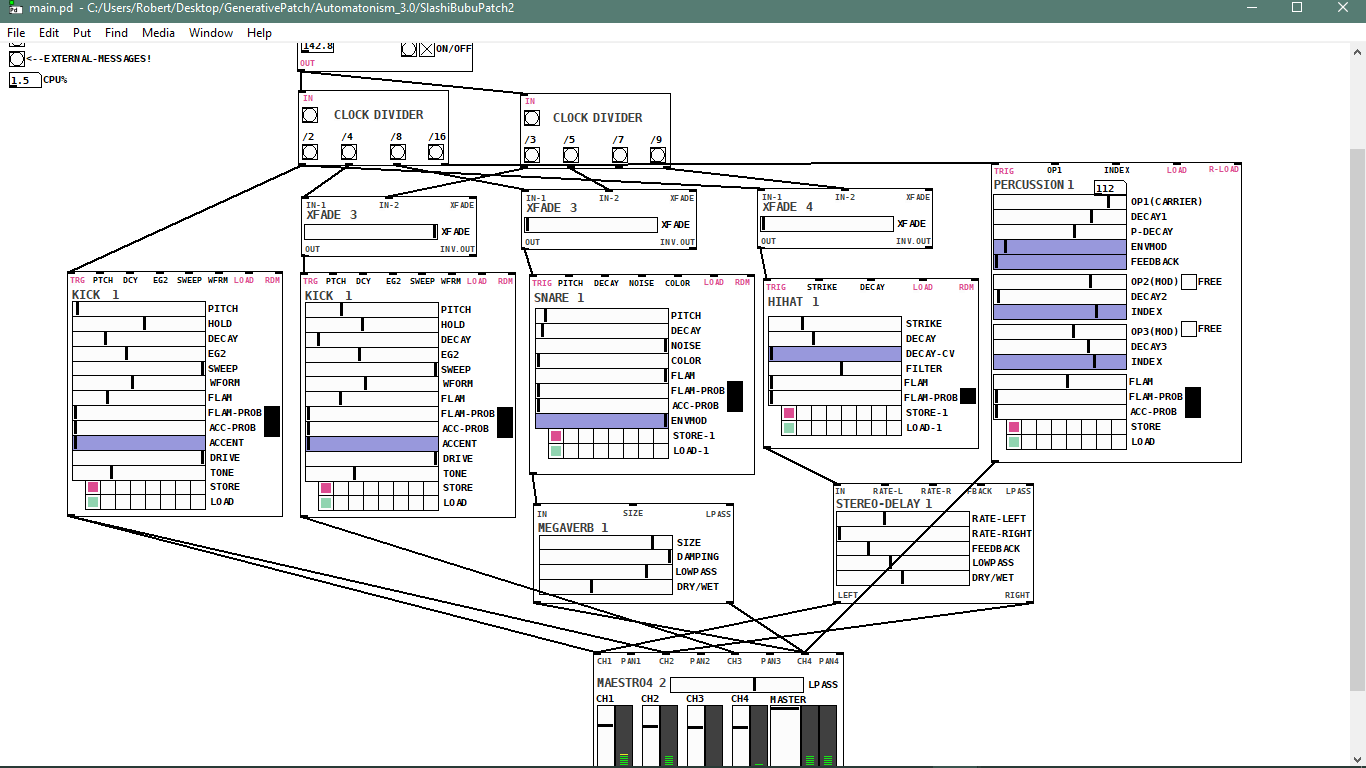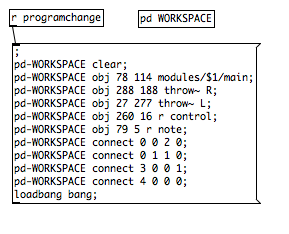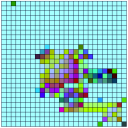Books about music
Maybe the concepts of design are keys to create a music based on synthetic sounds.
Thinking with lines, shapes, numbers and colors helps navigate the never ending possibilities of a software like Pure data.
Harmony, melody and rythme can be insufficient when anything can be organised with such wide liberty.
Modes can appear everywhere, relations between harmonics and shapes can come out of places that used to be desertic.
Materials and dimensions, utility and necessity, drag creation in other directions.
TitanOceans - Module for making methane oceans soundscapes.
TitanOceans is complex module for making oceanic soundscapes using different filtered noises. It is designed to reproduce real oceanic waves or synthetic waves of different digital emotions straight from Titan colony Beta-Omicron 657.
patch download :
TitanOceans.zip
snapshot :

Guava Rhythm patch using Automatonism v3.0 system
A simple rhythm patch that you can use in a jam night using synthetic modular juice.
patch download :
Rhythm Guava.zip

synthonic orchestra
I been working on synthetic jamming musician patches for a bit now. A buddy of mine (DJ K9NE) tossed me a beat and I hooked a little synthony up to it.
All instruments were played by virtual musicians listening to the beat a each other. They all played presets on the Yoshimi synth. I edited about 40% of their notes out in post.
I'm considering hammering it into either a sonata form by adding composing a lead voice, to use as the first movement of a sonata. I havent envisioned what the character of the soloist would be though. CC welcome!
https://soundcloud.com/deifius/wubdubdub-randoshi-session/s-ibCF3
Loading a pure data patch ( .pd file ) within a pure data patch ( .pd file )
I am accomplishing something similar, in a different way, so I don't have to use full paths. Chek out pdpi. In MAIN.pd I dynamically load a patch like this:

When it receives a float message on programchange, it dynamically loads the patch, then sends a synthetic loadbang message (dynamic loaded stuff doesn't trigger loadbang.)
To wire things up, I have a catch~ L, catch~ R hooked to dac~ and s control, and s note hooked to ctlin and notein
Loading a pure data patch ( .pd file ) within a pure data patch ( .pd file )
HI!
Quick version:
My folder structure:
/mother-patch.pd ( main pure data patch first loaded and running... )
/patches/1/main.pd
/patches/2/main.pd
/patches/3/main.pd
...
How i could open /patches/1/main.pd triggered by some action in the mother-patch.pd?
How i could close /patches/1/main.pd triggered by some action in the mother-patch.pd?
Long read
I'm attempting to clone the Critter and Guitari organelle ( link ).
This instrument is basically a computer running libpd and running very cool pure data patches
You can read more about my project here ( link )
I have a mother pure data patch that it's first loaded when the device is on, this patch is doing some [send] and [receive] operations related to the knobs/keyboard/volume/led and it should be also managing the loading ( opening and closing ) of the child pure data patches ( mentioned above ). This child patches are receiving the actions from the mother patch.
If I open the mother patch and the child patches manually, everything works fine. But now I need to OPEN this CHILD PURE DATA patches with a object within the mother patch.
I've been testing [open] , for opening the main.pd of the child patches but it does not work.
I've been testing [pd] , for opening the main.pd of the child patches but it does not work.
I wouldn't like to modify the original organelle patches.
I wouldn't like to end up loading all the patches using [pd ...] and inserting a [switch] object inside every main.pd file in the patches in order to enable only the dsp of the desired patch.
It would be perfect If i could have a folder with all the patches and load them within the mother patch with some kind of object. And I would also want to be able to CLOSE the pure data patch and open another ( changing patches... )
Every little and big help woul be MUCH APRECIATED!
THANKS!!!!!!!
Fairly efficient analog drums
For years I've been processing acoustic input sound but last week I wanted to do something with synthetic resonators. A friend suggested to try a recorded attack sample as the resonator input. That was a nice idea, but there was of course an important amplitude effect depending on the sample's frequency content. So I was looking for a way to construct a nice attack sample with 'white spectrum'. After hours spent on noise bursts and sweeps I gave up, it just did not work.
Today when loading Obiwannabee's old patch 'efficient-drums' it occurred to me that 'efficient-snare' could be such an almost white spectrum attack. Well it's not completely white but it comes close. So this is indeed the ideal resonator starter, and produces a more interesting resonance than a 1-sample pulse.
Attached is a demo patch [efficient-percussion] featuring a bateria de samba. All sounds are generated by one monophonic synth.
Katja
http://www.pdpatchrepo.info/hurleur/efficient-percussion.pd.zip
Patching a good reverb
Here's a pretty good reverb, it should be a "real" Lexicon algorithm (Concert Hall from the 224X, allegedly), but I can't confirm that. I've added a few enhancements. All necessary abstractions are included (and they may be useful on their own). It's definitely a step up from Schroeder-type algorithms. It's very synthetic sounding, but in a flattering way.
Here's the original: http://www.convexoptimization.com/wikimization/index.php/Dattorro_Convex_Optimization_of_a_Reverberator
It's not packaged as well as it could be, mainly because I'm trying to keep it in line with the original diagram. Of course it's possible to extend it further, but I'd rather start over with a new algorithm. This one has been taken about as far as is practical without sacrificing basic authenticity.
There's a lot of expr stuff, a couple non-Vanilla objects (lp8_cheb~ from iemlib), and possibly an implementation of a still valid patent (5553150, though I think there's some significant prior art that may render it unenforceable). And I don't guarantee that it won't kill your family. Use it at your own risk.
I have some fancier algorithms, but this one is nice sounding and reasonably efficient, so it gets a fair amount of use.
Korg Monotron emulator
Hi,
I'm fairly new to designing synthetizer with Pure Data and I was wondering if you could help with this undertaking of reproducing the basic fonctionalities of a Monotron with Pure Data, which is a small analog synthetizer that reproduces vintage synth sounds, as described here : http://www.korg.com/monotron. The page also contains the basic schematics, the full schematics are available here.
I've began to grasp what are oscillators, VCF and LFOs, but I still don't understand quite well how to plug them all together to emulate the analog circuitry of the synth. Understand that I don't want to absolutely reproduce the Monotron: a simple, vintage sounding synth would be a good start.
Thank you for your time.



